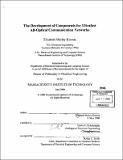The development of components for ultrafast all-optical communication networks
Author(s)
Koontz, Elisabeth Marley, 1970-
DownloadFull printable version (22.66Mb)
Other Contributors
Massachusetts Institute of Technology. Dept. of Electrical Engineering and Computer Science.
Advisor
Leslie A. Kolodziejski.
Terms of use
Metadata
Show full item recordAbstract
The need for ultrafast (greater than 100 Gbps) all-optical communication networks is amplified as the amount of data-containing communication traffic continues to grow at an exorbitant rate. Multiplexing schemes are attractive, as they enable increased transmission over silica fiber already buried and in use. One of the key components enabling Wavelength Division Multiplexed (WDM) propagation is the distributed feedback (DFB) laser. A periodic index modulation, typically buried within the device structure (hence requiring an overgrowth step), is used to select the specific operating wavelength of the laser. As the WDM wavelength spacing continues to decrease, the increasing demands placed on the fabrication of the DFB lasers bring the fabrication issues to the forefront. Similar patterned surface overgrowth issues need to be addressed for realization of wavelength-selective filters, e.g. Bragg-resonant filters, for all-optical routing. Issues pertaining to the formation of buried index contrasts, for application to future WDM network components, are addressed. Of importance to Time Division Multiplexed (TDM)-based propagation schemes is the multiplexing and demultiplexing of the ultrafast data streams. All-optical switching as well as optical (de)multiplexing are very attractive alternatives to optoelectronic conversion. Many optical switching schemes require the use of a semiconductor optical amplifier (SOA) as the nonlinear medium, as well as optical clock sources with repetition rates on the order of GHz (for integration with electronic components). For TDM network propagation rates on the order of Tbps, lasers must be capable of producing pulses shorter than a picosecond. Mode-locking of laser cavities is an attractive method of ultrashort pulse generation. A semiconductor saturable absorber mirror is a monolithically integrated device utilized for passive mode-locking of a wide variety of lasers. The development of SOAs as well as semiconductor saturable absorber mirrors is discussed.
Description
Thesis (Ph.D.)--Massachusetts Institute of Technology, Dept. of Electrical Engineering and Computer Science, 2000. Includes bibliographical references (p. 149-158).
Date issued
2000Department
Massachusetts Institute of Technology. Department of Electrical Engineering and Computer SciencePublisher
Massachusetts Institute of Technology
Keywords
Electrical Engineering and Computer Science.